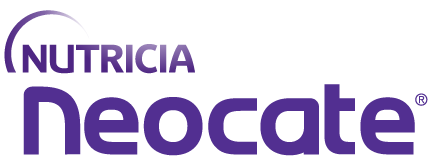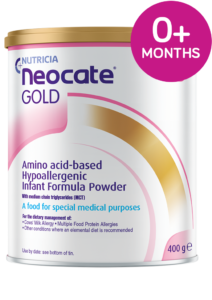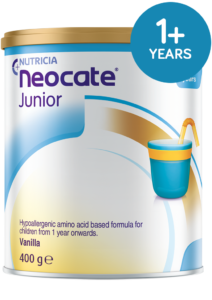Outgrowing cows’ milk protein allergy
Key takeaways
- About 80% of children will be able to introduce cows’ milk back into their diet at around 3-5 years 3
- Follow up with healthcare professionals regularly for monitoring

When should the symptoms disappear after eliminating cows’ milk protein from my child’s diet?
If your child has been diagnosed with cows’ milk protein allergy (CMPA) and you have successfully removed cows’ milk protein from the diet, it can take a little while for the body to get back to normal. The process is much like waiting for a cut to heal. For most infants and children, symptoms should improve within two to four weeks of eliminating cows’ milk protein from the diet.1 It is, however, important to discuss and monitor this with your doctor as this time frame may vary.
Eliminating cows’ milk protein can be challenging. After it has been removed from the breastfeeding mother’s diet or your child has been changed to a suitable formula, you are well on track to managing the allergy. Of course, if cows’ milk protein is consumed, either through changing formula or in the diet of the breastfeeding mother, symptoms could return.
If your infant is prescribed an extensively hydrolysed formula (eHF) and symptoms do not improve after two to four weeks, your doctor might consider switching to an amino acid-based formula (AAF). If symptoms do not resolve on an AAF it may be time to consider a different diagnosis.1
What are eHFs?
Extensively hydrolysed formulas (eHF) are cows’ milk-based formulas that have been treated with enzymes to ‘digest’ or break down the proteins that cause an allergic reaction in infants with CMPA.2 Some sensitive children may still react with the tiny cows’ milk protein fragments found in these formulas. For these children, AAFs may be recommended.
What are AAFs?
Amino acid-based formulas (AAF) are made up of synthetic amino acids. Amino acids are the building blocks that make up protein. These formulas are suitable for the dietary management of children allergic to cows’ milk protein or with multiple food allergies.4
When should my child’s condition be reviewed?
All children with CMPA should have a regular follow up appointments with their doctors. Your child’s doctor will monitor3;
- Growth
- Height
- Improvement of symptoms and any ongoing symptoms
- General health
- How you and your child are managing the cows’ milk-free diet
Children with CMPA will generally need to follow a cows’ milk-free diet for at least 6 months after diagnosis.1 Eventually, the check-ups will also assess if your child is ‘outgrowing’ the allergy and if cows’ milk can be re-introduced into the diet.
Will my child grow out of cows’ milk allergy?
The good news is that most children outgrow cows’ milk allergies. By the age of 3-5 years, around 80% of children will be able to re-introduce cows’ milk into the diet without any symptoms.3 In some cases, however, the allergy may persist although it is very rare for symptoms to continue into adulthood.2
Your doctor will re-evaluate your child periodically to check if it is safe to re-introduce cows’ milk. This process may include several tests, such as skin prick testing, blood tests, and/or oral food challenges.1 The type of tests required will depend on the severity of the allergic reaction.
A positive allergy test may not necessarily mean that your child is still allergic to cows’ milk protein. It may mean that a food challenge, under the direction of a paediatric specialist, may be needed to prove that CMPA has been completely outgrown.5
This article is not intended to be a substitute for medical advice. Always consult your doctor.
References accessed 28th July 2021:
- Vandenplas Y, et al. Guidelines for the diagnosis and management of cows’ milk protein allergy in infants. Arch Dis Child. 2007;92:902-908.
- Australasian Society of Clinical Immunology and Allergy (ASCIA). Cows’ milk (dairy) allergy 2019. Available from: http://www.allergy.org.au/patients/food-allergy/cows-milk-dairy-allergy (Accessed July 2021).
- Motala & Fiocchi. 2012. Cow’s milk allergy in children. World Allergy Organisation. Available from: https://www.worldallergy.org/education-and-programs/education/allergic-disease-resource-center/professionals/cows-milk-allergy-in-children (Accessed July 2021).
- Kemp et al. Guidelines for the use of infant formulas to treat cows’ milk protein allergy: An Australian consensus panel Med J Aust. 2008;188:109-112.
- Australasian Society of Clinical Immunology and Allergy (ASCIA). Food Allergy – Frequently Asked Questions 2021. Available from: https://www.allergy.org.au/patients/food-allergy/faqs (Accessed July 2021)






